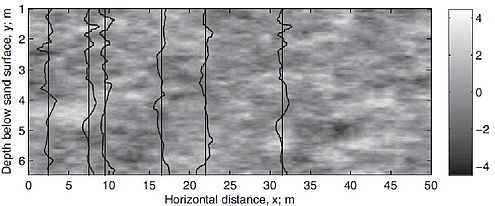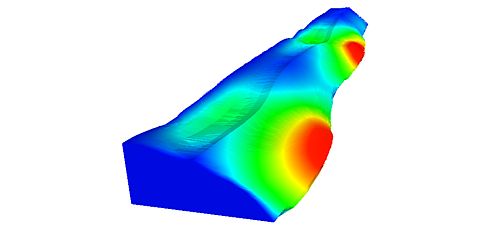Heterogeneity and Uncertainty
The section Geo-Engineering specialises in the research, development and application of novel numerical and probabilistic methods for geotechnical engineering. It previously initiated the development of the commercial finite element code PLAXIS and continues to develop a major research line in the stochastic modelling of soil heterogeneity and geotechnical uncertainty.
The section participated in two EU programmes in this area. IRIS was a large integrated programme for developing an “Integrated European Industrial Risk Reduction System” (2008-2012). A strategy for assessing the liquefaction potential of tailings dams, hydraulic fills and underwater slopes was developed, involving the stochastic characterization of in situ data and modelling of slope reliability using the Random Finite Element Method (RFEM). Slope liquefaction slides that occurred during construction of the Jamuna River Bridge in Bangladesh were analysed and results demonstrated a direct link between larger vertical correlation distances of the soil properties and an increased tendency for slope liquefaction. Meanwhile, GEO-INSTALL, a Marie Curie Industry-Academia Pathways and Partnerships Project (2009-2013), demonstrated the relative performance of different construction and soil improvement methods on sand state, spatial variability and liquefaction potential, using a large CPT database obtained from artificial sand islands used as oil exploration platforms in the arctic. A new approach was developed for optimising the characterization of in situ spatial variability, based on linking CPT data and conditional random fields.

Typical conditional random field of normalised de-trended CPT tip resistance (from key publication Lloret-Cabot et al., 2014).
Other research investigates the influence of heterogeneity on the performance of different types of slope subjected to various external loadings: for instance, three categories of 3D slope failure, depending on the magnitude of the horizontal correlation distance of the soil shear strength compared to the slope height and length, have been identified. Based on this work, the influence of soil heterogeneity and slope length on the reliability of slopes that are very long in the third dimension is being investigated. The research is being used to benchmark and upgrade simpler probabilistic tools for practical dyke safety assessments. Simple unsaturated soil models have also been used to investigate the influence of heterogeneity on rainfall-induced slope failure and dyke instability due to seepage (through and beneath the structure), and in situ measurements have been linked with inverse modelling to reduce soil parameter uncertainty (and thereby optimise designs) in collaboration with Plaxis and Deltares. Research in heterogeneity and uncertainty is closely related to the theme Dykes and Embankments.

Influence of soil heterogeneity and length effects on embankment failure mechanisms and reliability (by the Random Finite Element Method).